This post is about a new paper just published online in the journal Animal Behaviour, titled “Web reduction by courting male black widows renders pheromone-emitting females’ webs less attractive to rival males” by Catherine Scott, Devin Kirk, Sean McCann, and Gerhard Gries! You can read the full text here (free access until 28 August, 2015). All photos and video are copyright Sean McCann.
This short video shows a male western black widow engaged in web reduction behaviour – a common element of the complex courtship rituals males perform on females’ webs. You can see him cutting some silk lines, then pulling silk out of his spinnerets with his last pair of legs, wrapping it around a bundled up section of the female’s web.
Web reduction behaviour is somewhat puzzling. This male black widow is attempting to convince a potentially cannibalistic female several times his size to mate with him. Destroying large areas of her home – which she relies on for both prey capture and protection from predators – is not the most obvious approach. So why do males do it (I know, the title of the paper probably gives this one away), and why do females let them?
Before we address the mystery of web reduction, let’s take a step back and set the scene for this story. It’s a pretty juicy one – there’s attraction, courtship, rivalry, and manipulation! Or maybe not manipulation… we’ll see!
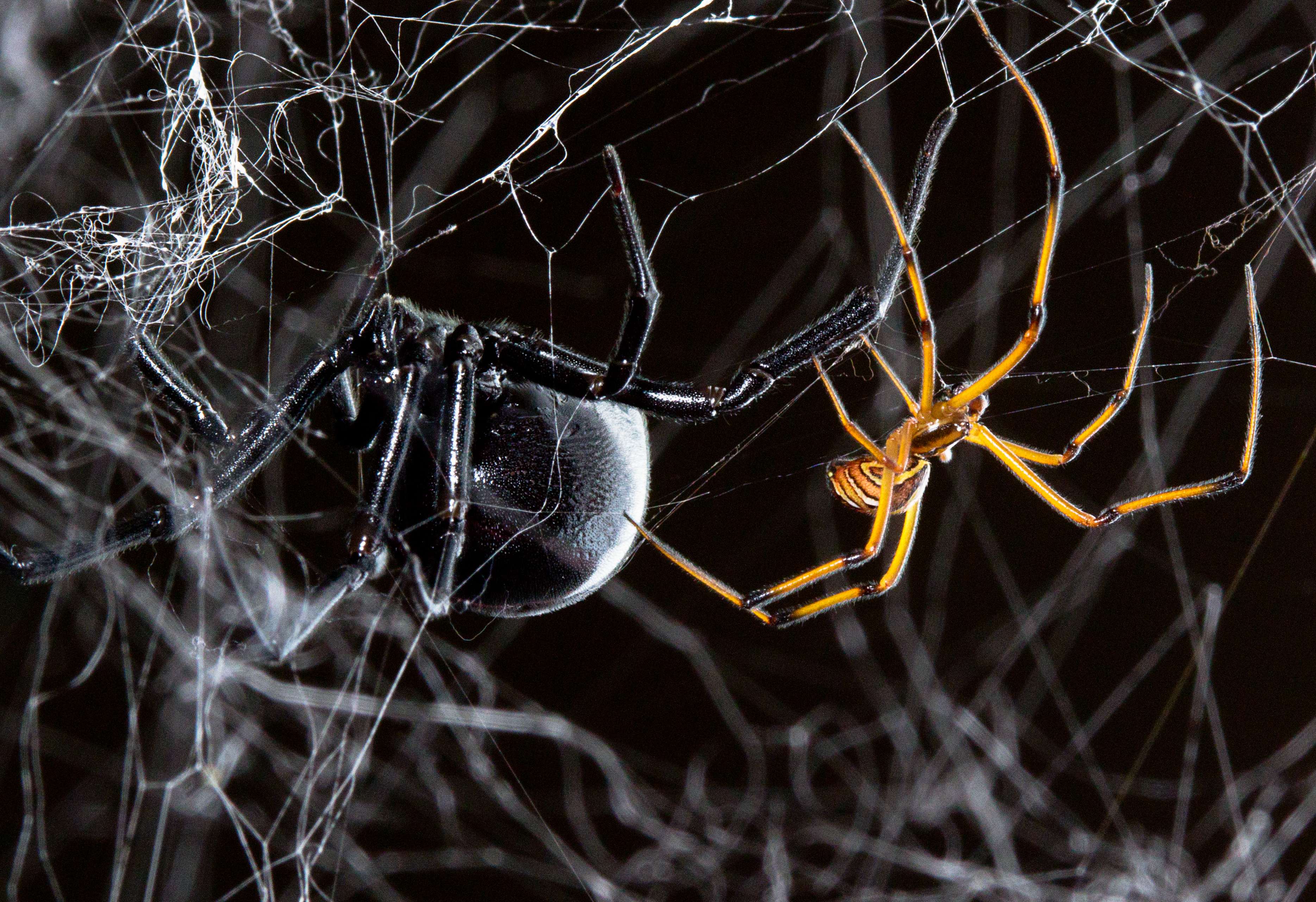
Black widows are sexually dimorphic: the familiar female is on the left, and the much smaller and more brightly coloured male is on the right. My study species is the western black widow, Latrodectus hesperus.
Island view beach, on the Saanich Peninsula of Vancouver Island, BC, is a beautiful place to visit. The site shown below is on the lands of the Tsawout First Nation, who have kindly allowed me to collect spiders and do field work here over the past few years.
This coastal sand dune ecosystem supports a great diversity of organisms, but the black widows are the dominant web-building spiders. Females build their tangle-webs under the driftwood logs at a density of 2-3 webs per square metre of available habitat. There are many logs on this beach; correspondingly, there is a huge population of widow spiders.
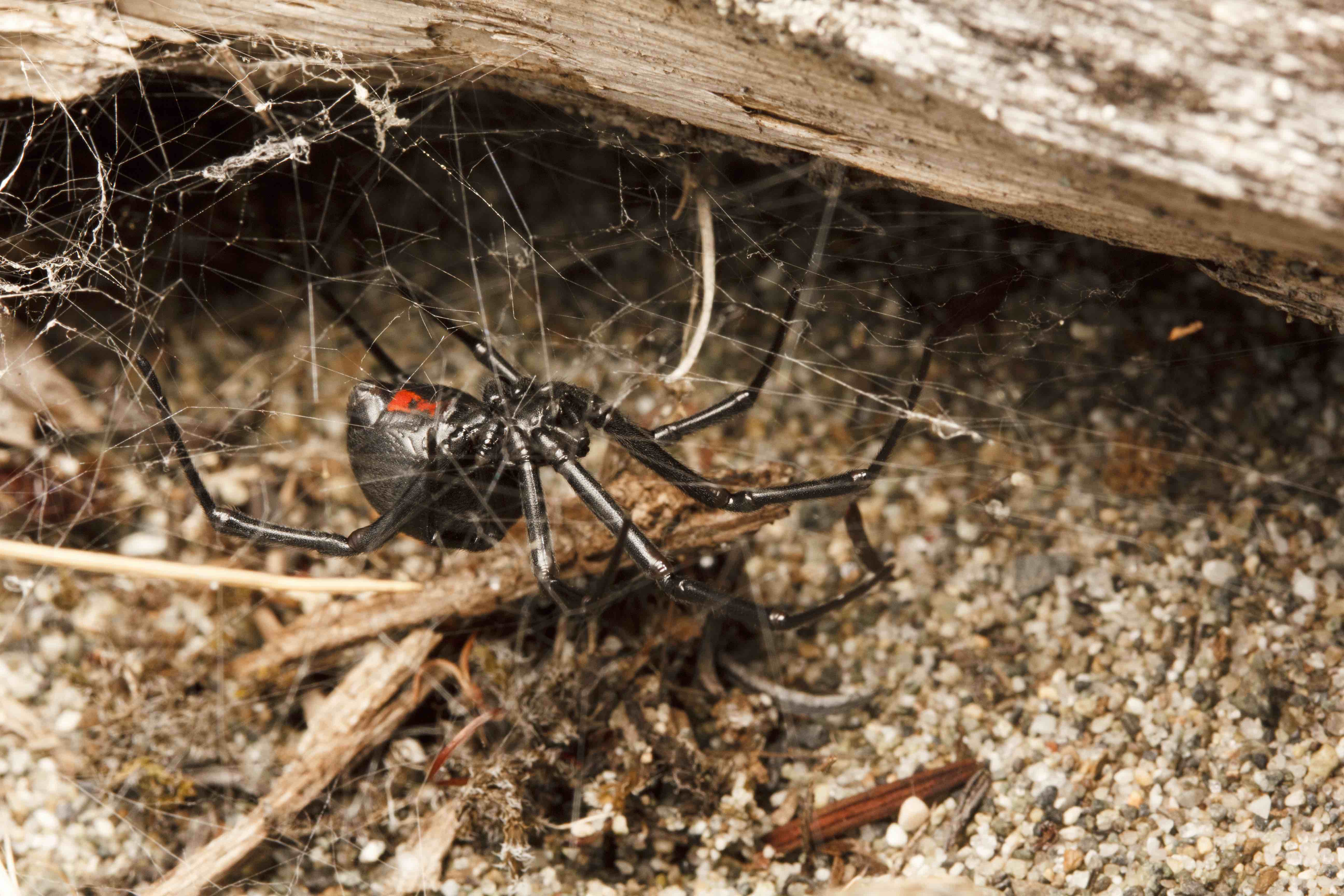
At our field site, black widows build their webs under driftwood logs – often several females can be found living under a single piece of wood!
Female black widows almost never leave their webs, so when it comes time to mate, they need males to come to them. The solution to this problem comes in the form of pheromones on their silk. These chemical messages are kind of like scent-based personal ads, that provide the male with information about the female’s mating status and whether or not she’s well fed (sexual cannibalism is rare in this species, but starving females will sometimes eat males!).
Adult male black widows have only one goal in life: find a female to mate with (and become the father of as many offspring as possible). Once they mature, males stop capturing prey and abandon their webs for a more a nomadic lifestyle. If they detect an attractive female’s pheromone in the air, they follow it to her web.
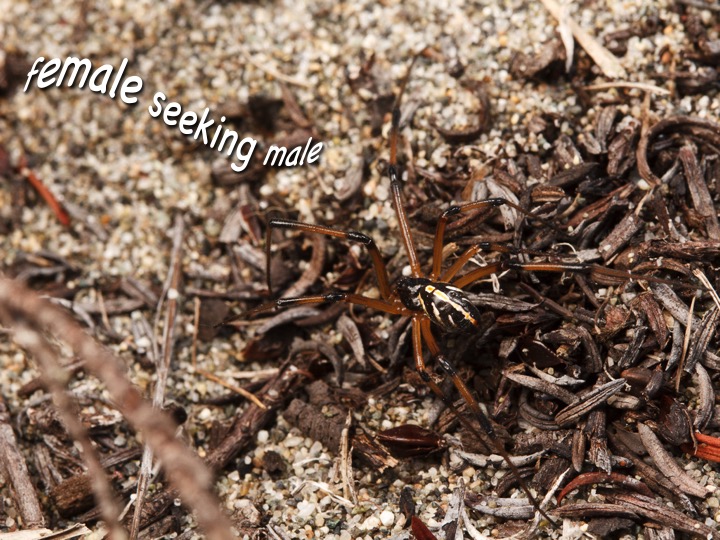
A nomadic western black widow male traverses the sand dunes in search of a mate. Note: “pheromone trail” added for dramatic effect.
Once he arrives on the female’s web, the male begins an elaborate courtship display, dancing on the web to transmit vibratory messages (including “male, not meal!”) to the female. It may take many hours of courtship before copulation finally occurs.
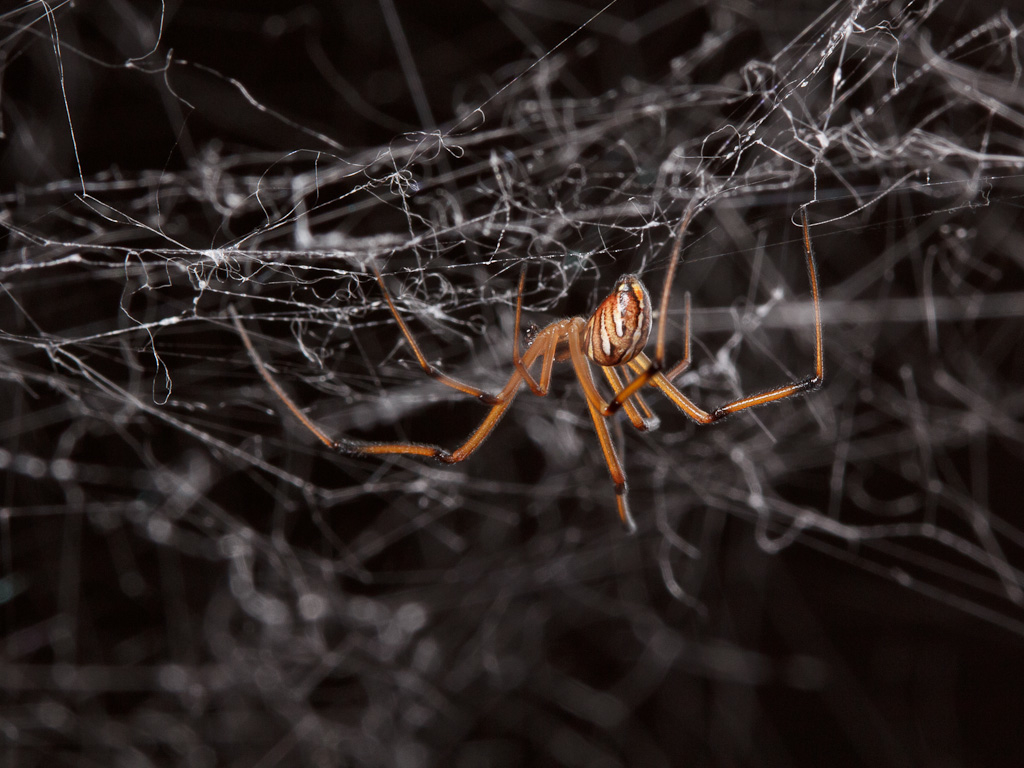 Soon after he arrives, the male may start to destroy the female’s web. He cuts out sections, bundles them up, & wraps them in his own silk. Males usually reduce the area of the web by about 50%, and gather the destroyed sections up into loose silk-wrapped packages. These can be rope-like (as in the photo at the top of this page) or a tighter ball that has been wrapped extensively by the male like the one below.
Soon after he arrives, the male may start to destroy the female’s web. He cuts out sections, bundles them up, & wraps them in his own silk. Males usually reduce the area of the web by about 50%, and gather the destroyed sections up into loose silk-wrapped packages. These can be rope-like (as in the photo at the top of this page) or a tighter ball that has been wrapped extensively by the male like the one below.
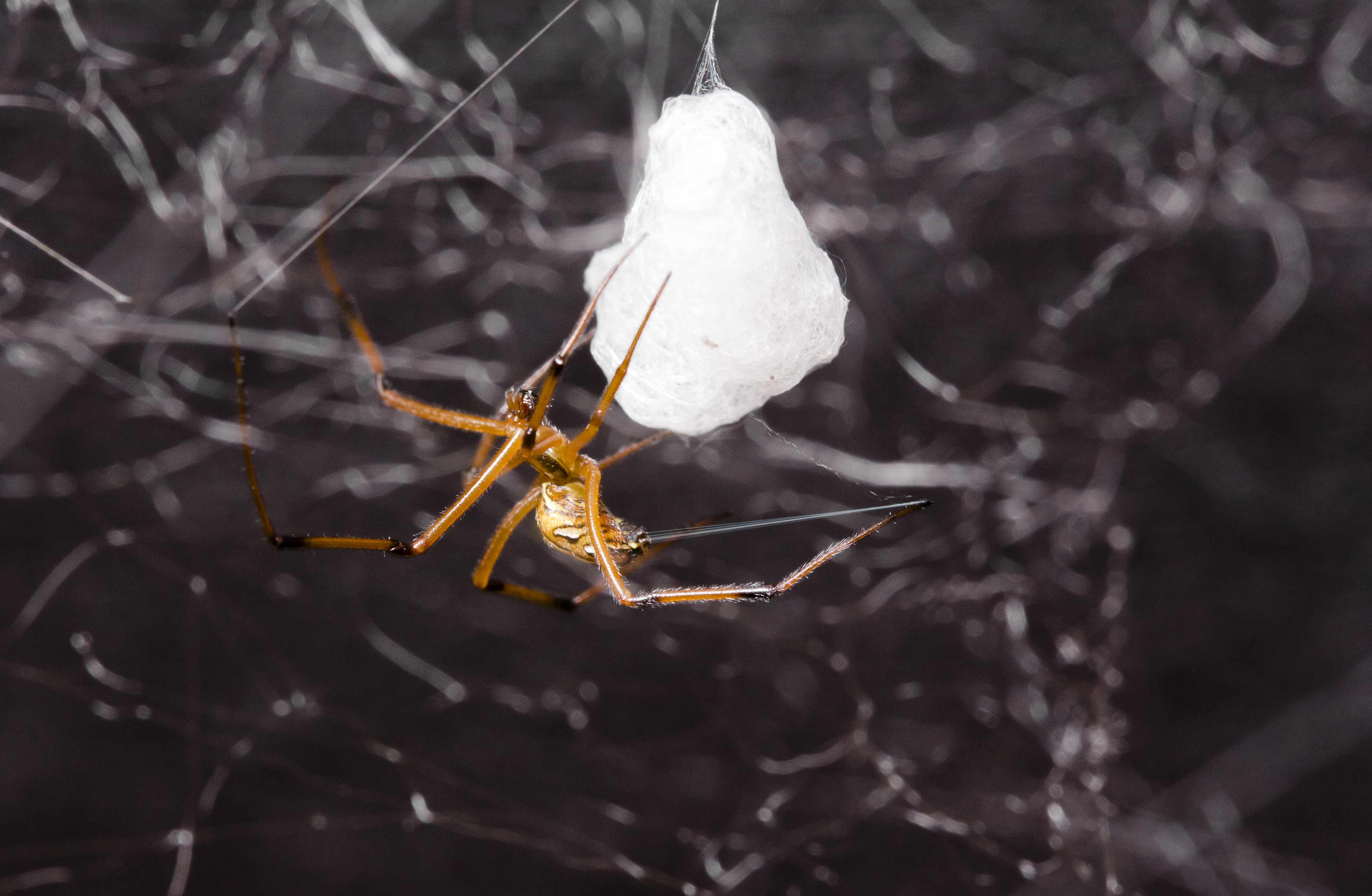 Now to address our earlier question: why do the males engage in this behaviour?
Now to address our earlier question: why do the males engage in this behaviour?
Well, black widows are not the only spiders who do web reduction. Other species in the same family (Theridiidae) and others (including Linyphiidae) have similar behaviour. Watson showed in 1986 that web reduction in the sierra dome spider makes the female less attractive to rival males. He concluded that by bundling up the female’s web, the male decreases the surface area from which the silk-borne sex pheromone is released. Some researchers have assumed that it works the same way in other species. Others have suggested that web reduction could function in communication between the male and the female, perhaps improving vibration transmission through the web, or transmitting a male silk pheromone to the female. It could have one or both of these functions in black widows, but until now, no one had ever investigated!
We set out to determine whether web reduction decreases female attractiveness to male black widows in a natural setting. We were pretty sceptical that reducing the web surface area by only about 50% could limit pheromone emission. Usually you have to decrease the dose of a pheromone by an order of magnitude to see any difference in attractiveness. However, males aren’t just bundling up the female’s pheromone-laden silk – they are also adding their own. We thought maybe it could be the addition of the male’s silk (and associated pheromones) that keeps other males away. We designed an experiment to try to find out.
First, we put a bunch of female spiders in cages and allowed them to establish webs. Then we loaded up the cages and took them, and a batch of males, to our field site.
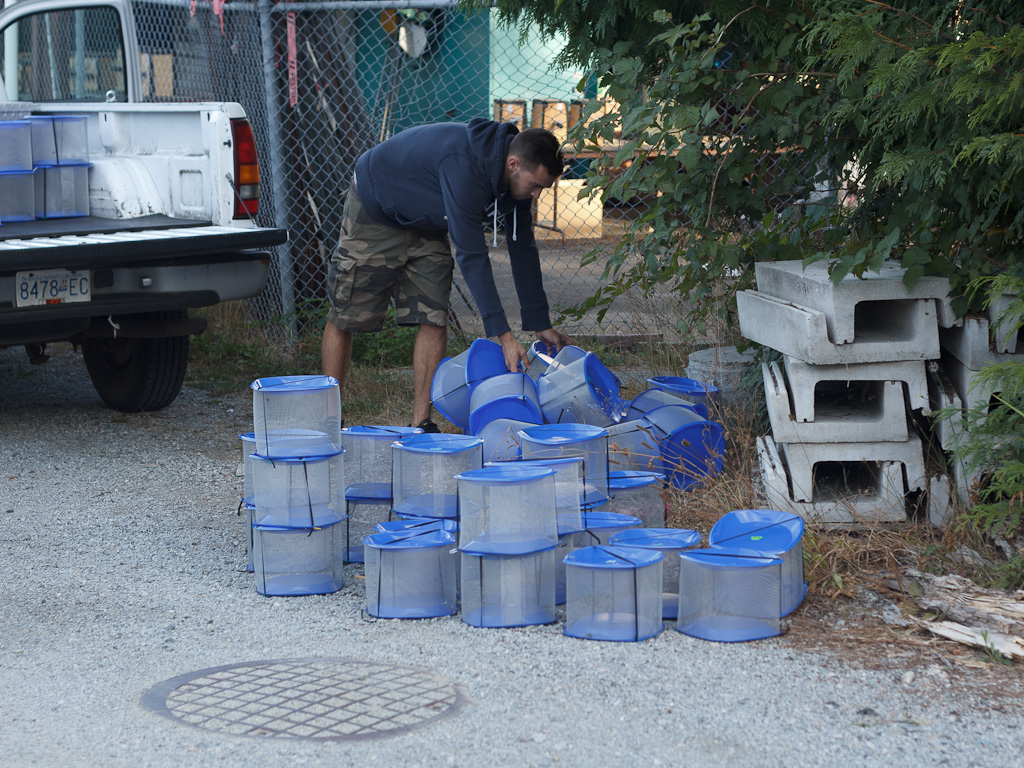
This is what (part of) a truckload of black widows looks like. Here, my coauthor Devin is loading the cages containing females and their webs into the back of the lab pickup.
Once we got to our field site, we removed the female spiders from their cages (because we wanted to look at the attractiveness of silk only, not the females themselves) and set up four treatments: intact webs, mechanically reduced webs (with half the silk cut out), male-reduced webs (with about half the silk, on average, bundled and wrapped by the males we brought) and empty cages as controls (to confirm that captured males were actually attracted to the silk in the cages, not just wandering randomly).

Four treatments: intact web, scissor-reduced web (50% of silk removed entirely), male-reduced web (courting males bundling up about 50% of silk on average), and no-web control.
We then turned the cages into traps that would capture any wild males attracted to the silk inside by surrounding them with sticky strips. Then we set the traps out on the beach in groups of four – one for each of the treatments.
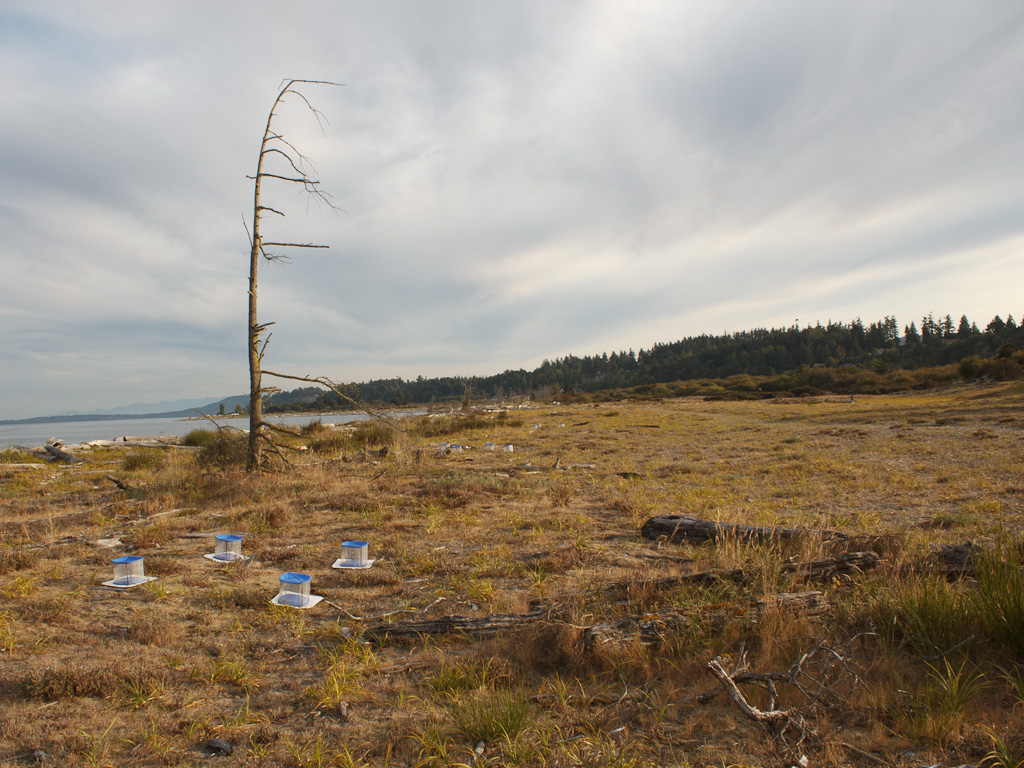
The experimental setup. Each of the four traps contains a different treatment, and the white sticky strips surrounding the cages trap males that are attracted to the silk inside the cage.
We set the traps out at sunset (black widows are nocturnal) and waited to see what would happen. Soon the data started strolling in. We checked the traps every three hours, collecting and preserving any captured males. The sheer number of males out on the prowl was incredible – some webs attracted more than 10 males overnight!

Close-up of a trap containing a pheromone-laden female’s web, with a male black widow captured outside on the sticky strip.
After 24 hours, just by looking at the vials full of male spiders we had captured, the results were clear (if you want to see statistics, you can read the paper!). Male-reduced webs caught only about one third as many males as intact webs, so web reduction does in fact decrease attractiveness! As we suspected, however, removing half of the silk entirely did not significantly reduce a web’s attractiveness – we captured almost as many males outside scissor-reduced webs as intact webs. (A few spiders got trapped outside the empty control cages – they may have blundered into the sticky strips on their way toward an an attractive web.)
Evidently, when a male black widow reduces a female’s web, whatever he is doing is much more effective at decreasing its attractiveness than removing half of the pheromone-laden silk entirely. And he’s not actually removing any of the female’s silk – he’s just bundling it up into a ball. There are a couple of potential explanations for how web reduction works. Perhaps the female’s pheromone is not evenly distributed on the web, and the male targets the pheromone-rich silk for web reduction. Then, by wrapping those sections up in his own silk, he creates a barrier that limits the emission of the female pheromone. Another possibility is that the male’s silk has its own pheromone on it, one which other males detect and avoid. Or it could be a combination of both these mechanisms – we’re still not sure. We did another experiment to test the second idea, but the results neither supported nor completely ruled it out (see the paper for more details!). We will try to get to the bottom of this in the future.
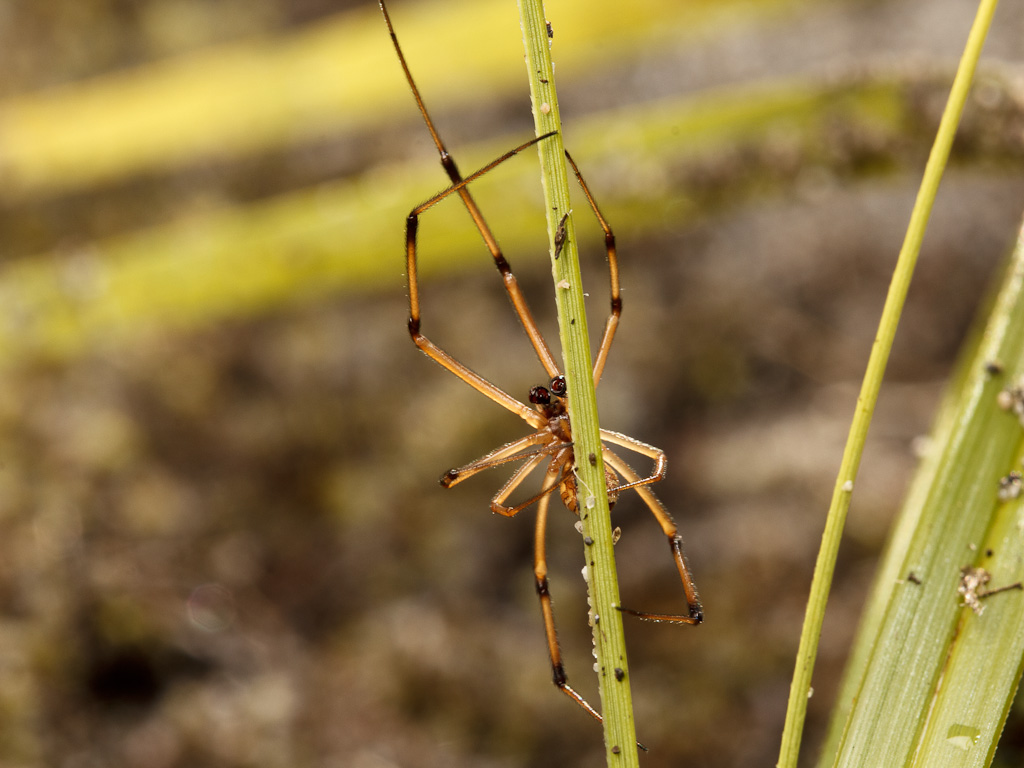
Time for a cute male widow interlude! Look at him peeking out from behind that blade of grass.
For now though, let’s come back to the questions we set out to answer. Why do male black widows do web reduction? It allows them to monopolize the female, by making her web less attractive to other males. Courtship and mating last several hours, so if a male reduces the female’s web as soon as he arrives, he can decrease the likelihood of rival males arriving and interrupting. This may be very important at our field site, where competition for access to females appears to be fierce – during our second experiment, we had one intact web attract over 40 males in a single night! So web reduction is good for the male, because it helps him to avoid competition.
What about the female? Losing her web may be costly – she has to spend time and energy rebuilding it. However, we think she might actually benefit from web reduction too, and that the benefits may outweigh the costs. Sure, her web is important for prey capture and protection, but it’s also really attractive. So attractive, in fact, that even if she doesn’t add more pheromone, it will continue emitting its “come-hither” message for several days. Given number of males we saw arriving at each web during our experiment (40 in one night! even 10 is pretty extreme!), remaining attractive once she has already found a mate might not be so great. Having a choice between multiple males might be a good thing, but the female really only needs to mate once to fertilize all of her eggs. By “muting” her chemical signal though web reduction, the male might be doing her a favour: allowing her to rebuild her web without attractive pheromones (female sex pheromone production shuts off immediately after mating in black widows, but they don’t ever take down their existing webs). Rather than having to waste time and energy chasing off superfluous suitors, this may allow her to get on with the business of producing egg sacs!
References and further reading (also linked in the text)
Baruffaldi, L., & Andrade, M. C. (2015). Contact pheromones mediate male preference in black widow spiders: avoidance of hungry sexual cannibals? Animal Behaviour, 102, 25-32.
MacLeod, E. C., & Andrade, M. C. (2014). Strong, convergent male mate choice along two preference axes in field populations of black widow spiders. Animal Behaviour, 89, 163-169.
Salomon, M., Vibert, S., & Bennett, R. G. (2010). Habitat use by western black widow spiders (Latrodectus hesperus) in coastal British Columbia: evidence of facultative group living. Canadian Journal of Zoology, 88(3), 334-346.
Stoltz, J. A., McNeil, J. N., & Andrade, M. C. (2007). Males assess chemical signals to discriminate just-mated females from virgins in redback spiders. Animal Behaviour, 74(6), 1669-1674.
Watson, P. J. (1986). Transmission of a female sex pheromone thwarted by males in the spider Linyphia litigiosa (Linyphiidae). Science, 233(4760), 219-221.
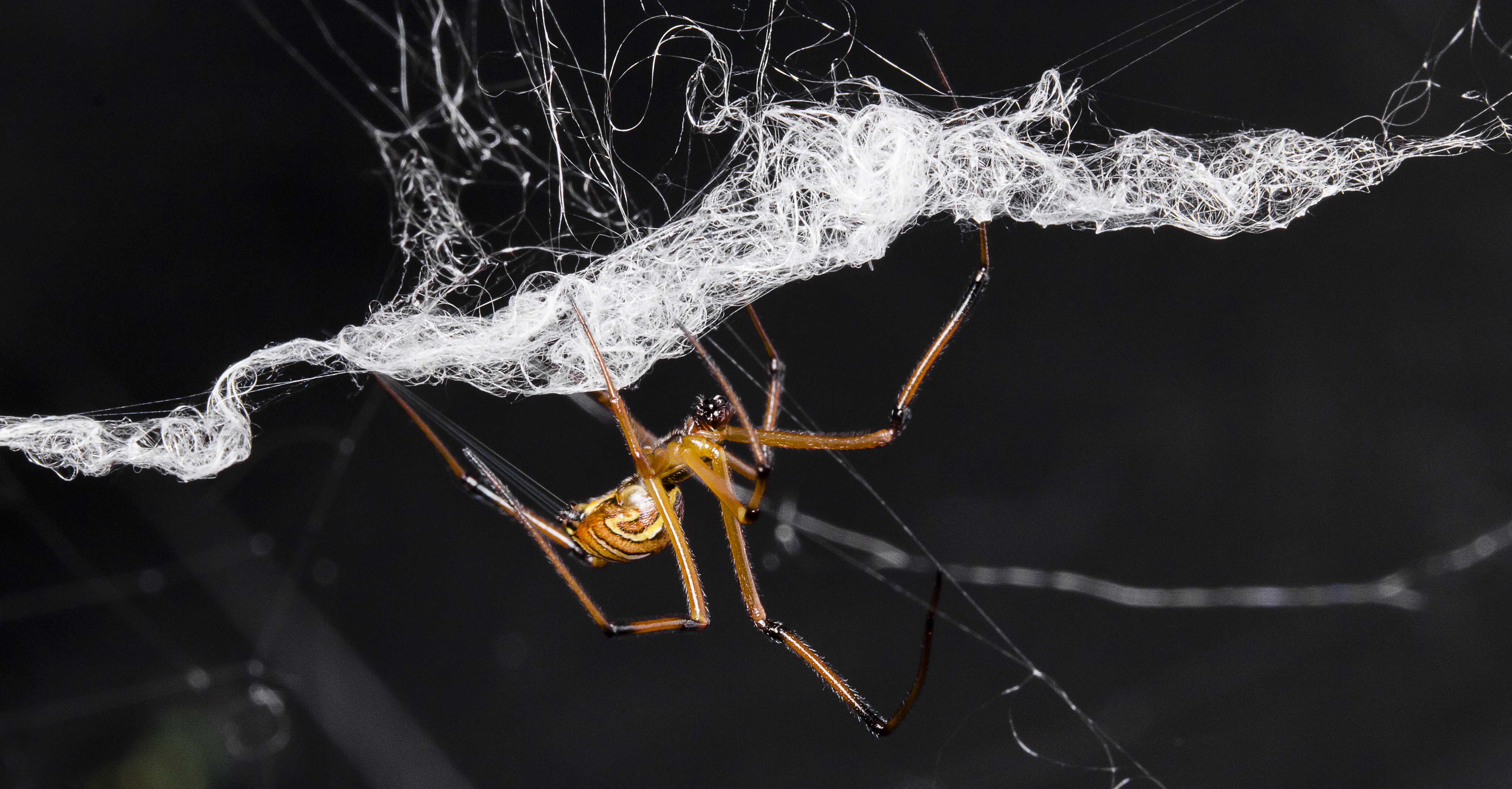

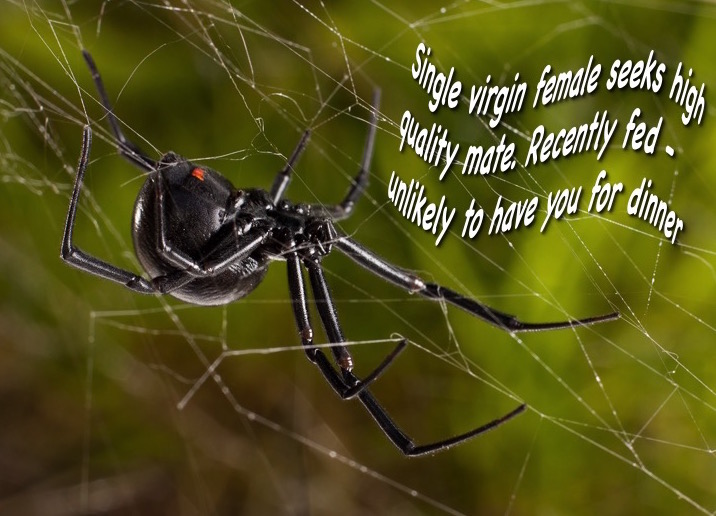
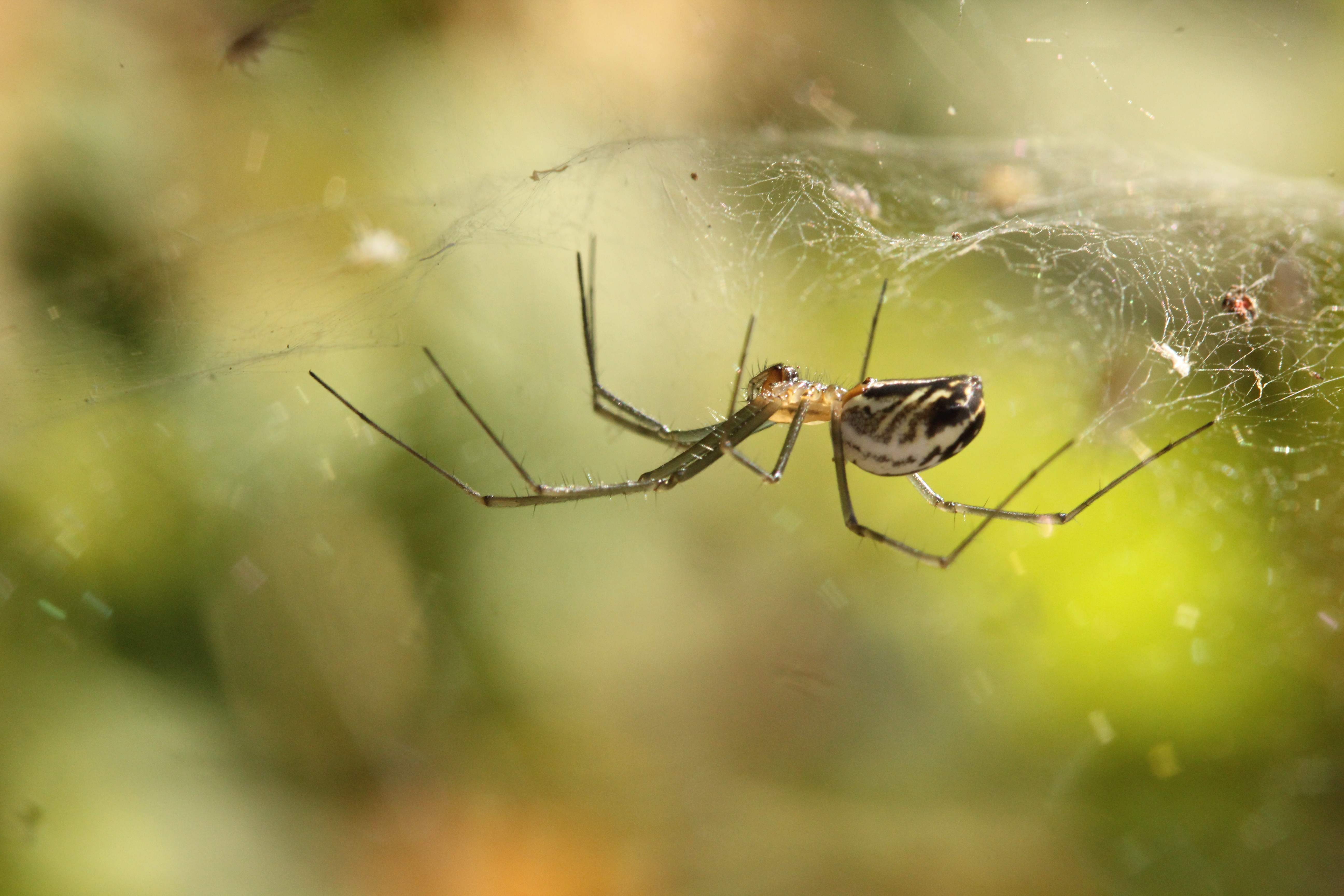

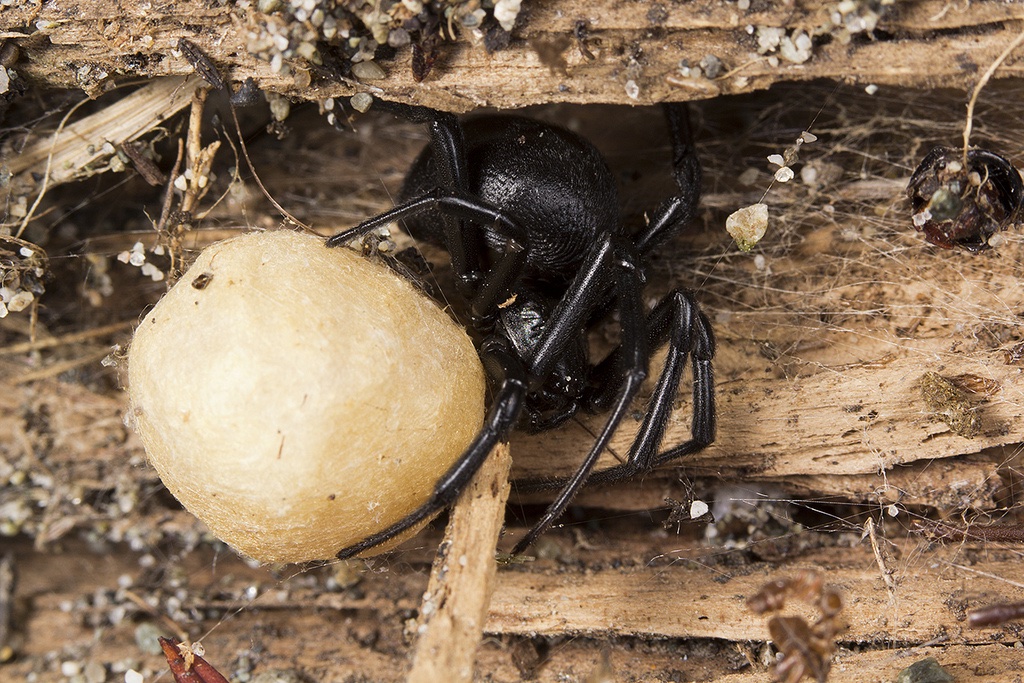
Very cool subject, and I love the experiment. Do you think sexual selection might be at play here? If females behave favorably toward males who vandalize their webs, they miss out on mating opportunities. But by mating with a vandal male, perhaps a female black widow can ensure that her male offspring are also vandals, and so have an advantage. Maybe she puts up with monogamy so that her male offspring can also have monogamous mates?
But then, the tolerant female’s female offspring might be at a disadvantage, since they will be more likely to put up with vandals. I guess it sort of depends on the sex ratios of her progeny, and if it’s better for a black widow to invest more in her male offspring than her female offspring. Or maybe none of this is relevant whatsoever. That’s also a possibility 🙂
Evolution is great for mind games.
Pingback: Sex pheromone on the silk of black widow females – more complicated than we thought | spiderbytes
Pingback: Morsels For The Mind – 10/07/2015 › Six Incredible Things Before Breakfast
Pingback: Crowdfunding black widow research | spiderbytes
Great experiment ! It would be really cool to find out why females tolerate males doing the web reduction. Joseph’s hypothesis in above comment also seems plausible and I would like to add that they would not be at disadvantage in case of female offspring as they would still be getting benefits through their grandsons. Expanding your hypothesis, females might be tolerating it because multiple mating actually does some harm to the female (maybe reduced fitness consequences) and so it actually is advantageous for female to remain monogamous and in that case it would benefit her to mate with a vandal male to produce vandal sons and monogamous daughters. We can go on and on with numerous hypothesis but it would be really exciting to test one of these , please update if you follow up on any of these.
This was a great experiment! The storyline was also quite fascinating. Great work!!